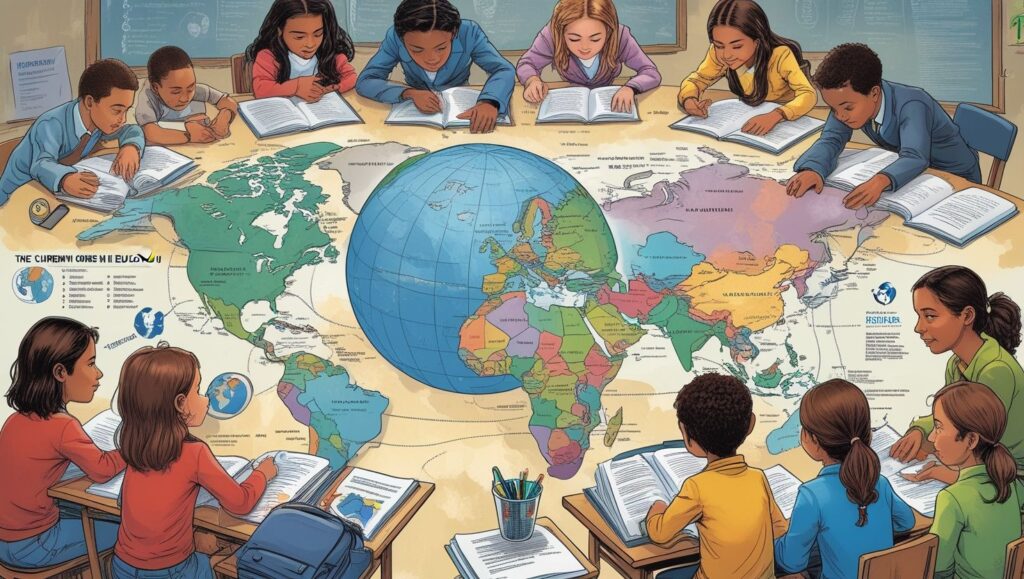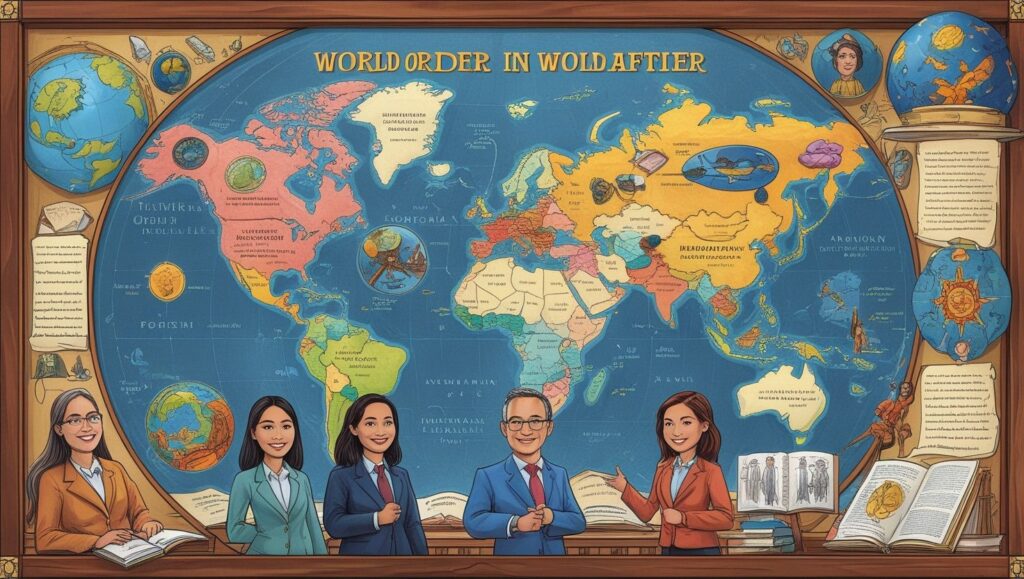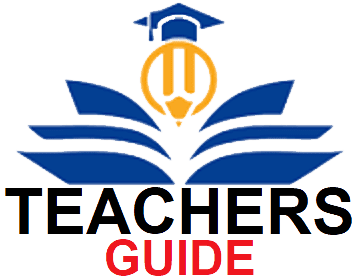Introduction:
Current Affairs of World Order in Education, In the twenty-first century, the current affairs of world order in education continue to shape how societies learn, grow, and connect. Education is no longer a local affair. Instead, it has become a global necessity linked with progress, equality, and innovation. Nations are now facing dynamic transitions due to political shifts, climate change, and technological revolutions. As a result, classrooms reflect these changes. For instance, digital learning has created bridges across borders. Similarly, students are now more connected to global issues than ever before. Yet, challenges remain. Inequality in access to education continues to create divides.
Therefore, governments, international organizations, and private institutions must adapt their policies. By working together, they can ensure inclusivity. Moreover, education is increasingly tied with sustainability, peace, and cultural exchange. Thus, the world order in education mirrors the global order itself. While developed countries invest heavily in research and advanced skills, developing regions strive to overcome barriers. This balance of opportunities and struggles defines the present. Ultimately, examining these realities allows us to understand the challenges and possibilities shaping the global educational landscape.
Globalization and Its Educational Impact
The role of globalization in education is undeniable. Today, borders have become less relevant for learning. International collaboration has expanded opportunities for both students and teachers. Universities exchange scholars, and online platforms connect learners worldwide. Because of globalization, cultures, languages, and ideas intersect more frequently. However, this connection also creates concerns. For example, local identities and traditional learning practices sometimes face risks of erosion. Still, many argue that globalization helps societies progress toward mutual understanding. Furthermore, governments are adapting curricula to reflect international standards.
As a result, global literacy has become as important as national literacy. Students are encouraged to think beyond their countries. In addition, issues such as migration, international conflicts, and trade agreements influence schools. Teachers are asked to integrate global knowledge into lessons. Thus, students learn not only about history and science but also about cultural sensitivity. Nevertheless, globalization is not equally beneficial. Wealthier nations gain more advantages, while poorer countries struggle with limited resources. Consequently, addressing this gap is a priority. In conclusion, globalization has deeply influenced the current affairs of world order in education, creating opportunities and challenges at the same time.

Technology and the Digital Transformation of Learning
In recent decades, technology in education has become one of the strongest forces of transformation. The COVID-19 pandemic accelerated digital adoption. Suddenly, online platforms, video conferencing, and digital libraries became mainstream. This digital shift has made education more flexible and borderless. Students from distant regions can now attend international lectures. Teachers can share innovative practices with peers worldwide. Moreover, artificial intelligence, virtual reality, and adaptive learning tools are reshaping teaching. Nevertheless, there are concerns about digital divides. Not every student has access to reliable internet or devices. This inequality creates a new form of educational gap.
Governments are, therefore, called upon to provide infrastructure. Additionally, the digital environment raises questions of privacy, security, and mental health. Despite these challenges, technology continues to drive innovation. For instance, language barriers are reduced through instant translation tools. Furthermore, online collaboration fosters teamwork across cultures. Consequently, the world order in education now includes digital competencies as core skills. Those who master them are better prepared for global opportunities. Hence, technology stands as both a bridge and a barrier in modern education.
Equity and Access to Education Worldwide
The question of educational equity is central in the current world order. Access to quality education remains uneven. Many children in developing countries still lack basic opportunities. Poverty, political instability, and gender discrimination are major barriers. Furthermore, wars and climate disasters often disrupt schooling. However, international organizations, including UNESCO and UNICEF, continue to promote equal access. Scholarships, aid programs, and awareness campaigns aim to close these gaps. At the same time, digital initiatives provide innovative solutions. Online classes and open resources allow disadvantaged learners to access global knowledge. Despite these advances, disparities remain visible. Urban students often enjoy better schools compared to those in rural regions. Similarly, girls in certain societies still face restrictions.
Therefore, governments must prioritize inclusive policies. Additionally, community participation plays a key role. Parents, teachers, and local leaders can support vulnerable groups. By creating safe environments, they ensure long-term benefits. Consequently, improving access strengthens economies and democracies alike. Ultimately, equity in education represents fairness, justice, and sustainable growth. Unless global efforts focus on it, the current affairs of world order in education will remain incomplete.

Cultural Exchange and International Collaboration
Another important dimension in the world order of education is cultural exchange. Students now travel across continents for higher studies. Similarly, exchange programs allow teachers to experience new systems. These interactions broaden perspectives. They also promote respect and appreciation of diversity. For instance, Asian students studying in Europe often return with new skills that help their home countries. Likewise, Western institutions benefit from diverse student populations. Moreover, cultural collaboration encourages peace. When young people understand global perspectives, they are less likely to accept stereotypes. International organizations encourage this practice. Programs like Erasmus in Europe or Fulbright in the United States highlight its significance. Furthermore, art, literature, and language programs bring societies closer.
Yet, cultural exchange is not without challenges. Sometimes, students face identity struggles or discrimination abroad. Therefore, institutions must build supportive environments. In addition, governments should simplify mobility procedures. Scholarships and financial aid also strengthen participation. Overall, cultural exchange helps balance the current affairs of world order in education. By embracing diversity, students and teachers contribute to global harmony, innovation, and knowledge-sharing.
Policies and Global Educational Governance
Strong educational policies form the backbone of global progress. In today’s world order, international organizations influence education systems heavily. UNESCO sets benchmarks for sustainable goals. The OECD guides best practices. Meanwhile, governments align national frameworks with these global standards. Consequently, there is a strong emphasis on quality, inclusivity, and innovation. Moreover, cooperation between countries allows shared solutions. For example, tackling climate education requires global efforts. Similarly, migration policies affect student integration across nations. Nevertheless, political conflicts and differences often slow progress. Developing countries may resist adopting international frameworks due to economic constraints. Still, policy harmonization is crucial. Without it, educational inequalities may grow.
Furthermore, policies must adapt to modern realities. Digital learning, refugee integration, and environmental awareness require urgent attention. International funding, teacher training, and curriculum development are central tasks. Therefore, governments must cooperate and prioritize long-term reforms. Ultimately, strong policies reflect the current affairs of world order in education. They ensure that education remains a universal right, a driver of economic growth, and a force for social stability across nations.
Challenges and Opportunities in the Global Educational Order
Finally, the current affairs of world order in education present both challenges and opportunities. On one hand, inequality, political conflicts, and digital divides remain pressing concerns. Many regions face underfunded schools and poorly trained teachers. On the other hand, global awareness is increasing. Young generations are more conscious of climate change, peace, and social justice. This awareness pushes education toward innovation. Furthermore, collaboration between governments, NGOs, and private organizations provides hope. Investments in digital infrastructure and inclusive policies offer solutions. Moreover, global crises often accelerate change.
For instance, the pandemic revealed weaknesses but also encouraged new models. Hybrid learning, cultural partnerships, and community involvement emerged as powerful tools. Therefore, it is crucial to balance challenges with opportunities. Teachers must act as global citizens. Students must embrace diverse knowledge. Policymakers must address inequalities while supporting creativity. Ultimately, the future of the world order in education depends on collective action. If societies collaborate, education will continue to evolve into a tool for peace, progress, and sustainability across the world.
Conclusion: A Dynamic Future for Education
The current affairs of world order in education highlight an era of transformation. With globalization, technology, cultural exchange, and international policies, education has become the foundation of global development. At the same time, challenges such as inequality, digital divides, and political instability persist. However, opportunities exist to bridge these gaps through collaboration, innovation, and inclusivity. Ultimately, education is the shared responsibility of all nations. It reflects global realities while shaping future generations. Therefore, addressing these affairs is not only an educational duty but also a moral obligation.
References
- UNESCO. (2023). Global Education Monitoring Report. Paris: UNESCO Publishing.
- OECD. (2022). Education at a Glance: OECD Indicators. OECD Publishing.
- UNICEF. (2021). Education and Equity. Retrieved from https://www.unicef.org.
- World Bank. (2022). The State of Global Education. Washington: World Bank Publications.
- Altbach, P. G., & Knight, J. (2020). The Internationalization of Higher Education: Motivations and Realities. Journal of Studies in International Education.


This gave me a lot to think about. Thanks for sharing.
I appreciate your unique perspective on this.
I’ll definitely come back and read more of your content.
This was a great reminder for me. Thanks for posting.
I’ve read similar posts, but yours stood out for its clarity.
Such a simple yet powerful message. Thanks for this.
You always deliver high-quality information. Thanks again!
Fantastic read! I really appreciate how clearly you explained the topic—your writing not only shows expertise but also makes the subject approachable for a wide audience. It’s rare to come across content that feels both insightful and practical at the same time. At explodingbrands.de we run a growing directory site in Germany that features businesses from many different categories. That’s why I truly value articles like yours, because they highlight how knowledge and visibility can create stronger connections between people, services, and opportunities.Keep up the great work—I’ll definitely be checking back for more of your insights!